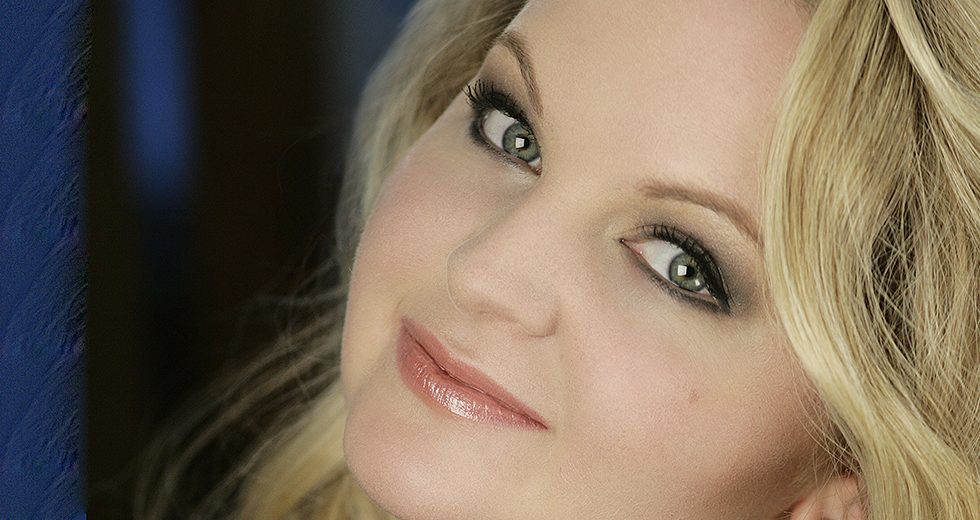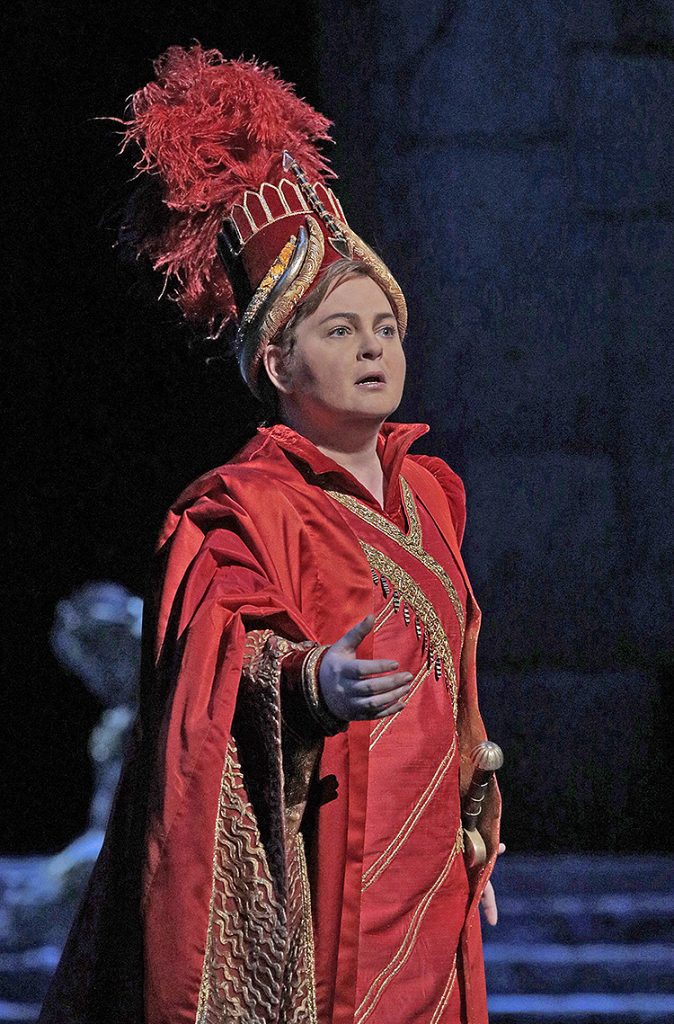
In social-media shorthand, mezzo-soprano Elizabeth DeShong identifies herself as #feminist #vegetarian #equalityadvocate. But those hashtags don’t begin to encompass the multi-faceted dimensions of DeShong, an alumna of Lyric Opera’s Ryan Opera Center, and a rapidly rising talent on the international classical music scene.
Now co-starring as Arsace in the Rossini rarity Semiramide at the Metropolitan Opera, the native of Selinsgrove, Pa., has received raves for her performance opposite Angela Meade in the title role. “DeShong has her first really major turn at the Met,” wrote Zachary Woolfe in the New York Times. “[Her voice] is agile, even and velvety.” Added Opera Wire: “The true star of the night was Elizbaeth DeShong as Arsace. From the first note to her last, she suited the vocal lines perfectly.” (Semiramide will be simulcast worldwide March 10 as part of the Met’s Live in HD series.)
Along with the Met, DeShong has appeared at the world’s leading houses and festivals, including the Vienna State Opera, English National Opera, Royal Opera/Covent Garden, Canadian Opera Company, Glyndebourne and Aix-en-Provence. She’s familiar to Chicago audiences for her acclaimed turns as Adalgisa in Bellini’s Norma (2016-17) and Fenena in Verdi’s Nabucco (2015-16) at Lyric Opera of Chicago and at Music of the Baroque. Although she has sung with major orchestras worldwide, she has yet to perform as a featured soloist with the Chicago Symphony Orchestra. But that will change when DeShong sings the world-premiere performances March 22-24 of Max Raimi’s Three Lisel Mueller Settings with the CSO under Riccardo Muti. Commissioned by the Poetry Foundation for the CSO, the work is set to texts by Pulitzer Prize winner Lisel Mueller, whose family fled Nazi Germany in 1939.
Of the new work, DeShong says, “I will take her words to heart and will do my best to paint the text with the appropriate colors.” The mezzo, who’s conserving her voice between Semiramide performances, agreed to answer some questions via email ahead of her Symphony Center run, on subjects ranging from her lifelong inspirations to her offstage passions. Expect to see a few more hashtags soon in her social-media presence: #CSOdebut and #worldpremiere.

In the trouser role of Arsace, the warrior prince unwittingly in love with his mother, mezzo Elizbaeth DeShong has been called “the true star” of the Met production of Rossini’s Semiramide. | Photo: Ken Howard/Metropolitan Opera
In the space of a few weeks, you’ll move from being a warrior prince of ancient Babylon to the world premiere of a contemporary work (with text written from a female perspective). How difficult is it to make the emotional and technical transitions that these roles require?
Honestly, because the repertoire is so varied, the transition will actually be easier. After months of inhabiting the role of Arsace and immersing myself in Rossini’s demanding score, it will be somewhat of a relief to present something in English that is more open to my personal expression of thought and emotion. Speaking from a female perspective will also be a welcome change.
Max Raimi, the composer of Three Lisel Mueller Settings, said he wrote the work for a “darker voice” — a mezzo — because “even the comic moments are touched with tragedy.” Have you had a chance yet to discuss the work with Max? What are your initial impressions of the piece?
I think that Max’s choice of writing for a “darker voice” lends a bit of weight and thoughtfulness to the text. It sits in a very palatable register for the listener. This will aid the audience, I think, in digesting the text and emotion more thoroughly in conjunction with the orchestration.
Max and I have discussed the music, but will meet face to face in Chicago to put the finishing touches on the interpretation. I recently read a description of Lisel’s body of work that stated, “Her work explores the difference between what we present publicly and our private, individual selves that people rarely see.” I think this perfectly describes what I have gotten from the texts that Max has chosen to set to music. While the themes are apparent, there is an openness about the text that allows each individual listener the opportunity to take away something very personal.
You’ll be making your debuts with the Chicago Symphony Orchestra as well with Riccardo Muti. How do you approach such an occasion? What do you admire about each?
I spent six years of my early career as a Chicago resident, so the CSO and Maestro Muti have been very much on my radar. It will feel like a homecoming, and in a way, a sort of “arrival” to perform these pieces in Orchestra Hall at Symphony Center.
After intermission, you’ll join the CSO and soloists in Schubert’s Mass in E-flat Major. Have you sung this work before?
This will be my first time taking part in Schubert’s Mass in E-flat Major. It might sound strange coming from a soloist, but I love that there are no arias or prolonged solos in the piece. This helps to maintain a certain unity from beginning to end, with the soloists primarily used to focus the text, as opposed to singularly voicing ideas. Also, Schubert’s omission of “Et unam sanctam catholicam et apostolicam ecclesiam” (“And [I believe] in one holy catholic and apostolic church”) helps to give room for even more unity by eliminating doctrine and inviting us to share in the over-all sentiment of the text.
You’ve said that whenever you need inspiration, you turn to recordings by Christa Ludwig. That’s an interesting and perhaps surprising choice. Could you elaborate?
I’m not sure it is as much “inspiration” as it is “truth.” There is an honest quality to Christa Ludwig’s interpretations. I find a similar truth and, I suppose, a certain passionate vulnerability that intrigues me, in recordings by Lorraine Hunt Lieberson. As much as I can admire a beautiful sound, it is the commitment to text that makes me listen. This is why I have also said that many women outside of my genre are equally inspirational. My iPhone playlists are full of Judy Garland, Etta James, Edith Piaf and Janis Joplin!
As Arsace, you’re following in the footsteps of a legend, Marilyn Horne, who helped to revive Semiramide after a century of neglect and who owned the role from the mid-’60s to early 1990s. Is there a sense of trepidation in taking on this part?
All opera singers step on stage and reinvent the past. We follow in the footsteps of those who have come before us, we learn from them. That said, the reason we go to see 25 performances of Madama Butterfly or La traviata or Boheme, is to see and hear something new, a new take on music and characters that we love. This repertoire is highly individual and should be performed as such. Regardless of the repertoire, I must learn the music on my own and make it my own.
You seem to have been born to sing Rossini and have triumphed in his works, from the lesser-known Maometto II to favorites like The Barber of Seville. Why do the composer’s works suit you so well?
I received a wonderful musical education from both Oberlin and Curtis that taught me style. I was introduced to every corner of operatic and concert repertoire — Rossini, Schubert, Berg, Mahler, Britten, Brahms, Wagner, Verdi, Schoenberg, Massenet, Adams, Strauss, Menotti. That education, combined with extensive piano training and a natural vocal flexibility all helped to make this repertoire an appropriate choice.
Angela Meade, who’s Semiramide to your Arsace, recently mentioned in a radio interview that she jokingly asked you to create her ornaments since you’re known for your skill in the task. But how does one write her/his own ornaments? Could you walk an average listener through the process?
We recently did Handel’s Alcina together, and we have half-joked about having me write ornaments for us both. We didn’t end up trying it, but I did write a cadenza for our Act 2 duet in Semiramide. Leah Crocetto and I sang my variation together in Bordeaux.
Writing ornaments goes right back to piano training and then sitting down to look at the text and the individual voice for which you are writing. As much as it is stylistic tradition to ornament repeats of vocal music, my preference is for those ornaments to be not only a vocal showcase, but to have dramatic intention. The ornaments must highlight the strengths of the individual and also serve to highlight the emotional needs of the drama. If you want to project a sense of excitement and impatience, scales that reach into the upper register might be useful. If my character is sad or pleading for relief, a descending arpeggio with added chromaticism might work best. If my character is trying to intimidate another man, accessing some chest voice could lend a certain masculinity. Singers don’t always get their preference when all is said and done, as opera is a collaborative process, but heading into the process with these choices in mind can be very useful.
You might have one of the best Twitter bios ever: “American mezzo-soprano most often found with a camera in her hand, a score in her purse, a petition in her inbox, and a vegetable on her plate.” Could you tell us more about your passions and the animating forces in your life?
It really is me in a sentence. Ha! I am a passionate observer and collector of moments. My photo blog, A Singer’s Suitcase, is a way in which I try to share a little bit of that with others. The way I see it, personally and artistically, there is something to learn in every moment of every day. Taking a split second to register the person who is lost in thought in the produce aisle of the grocery store, noticing the one bird that doesn’t fly away when you walk past it on the street, sharing a moment of appreciation with a stranger when you experience an unexpected moment of unity — this is where life really exists. Giving voice to our shared humanity through music has been my greatest pleasure in life.
TOP: Elizabeth DeShong by Kristin Hoebermann